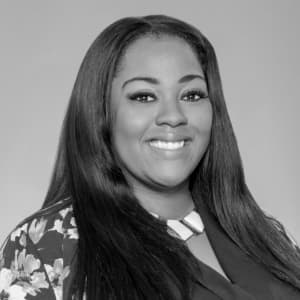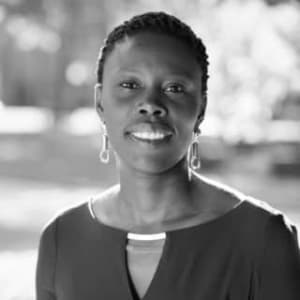Addressing the Underrepresentation of Black Women Among Tenured University Faculty

Edna Aurelus, DNP, FNP-BC, accepted a position six years ago as a tenure-track assistant professor. Her plan? To work hard toward fulfilling the requirements for tenure and receive a promotion.
As a tenure-track assistant professor, getting tenure and promotion guarantees job security. You also get a raise, better benefits, promotion, and not to mention prestige, says Aurelus.
“It was a grueling process. Thank goodness I was able to get both, but I worked my butt off,” she says.
But not everyone is as lucky as Aurelus. Underrepresented women in academia face long-standing barriers to full-time tenure-track faculty positions. The lack of minority faculty representation, and the gender pay gap in nursing faculty, continue to be an issue, despite the increase in diversity among college students.
Barriers Black Women Face When Seeking Tenureship
Tenure and promotion preparation begin in the first year of teaching. By the sixth year, candidates should be prepared to submit their applications for academic tenure. Applications are evaluated by several faculty committees, including the president of the university. Finally, the board makes the final decision to accept or decline.
Unfortunately, a major barrier Black faculty members face when seeking leadership roles is a greater level of scrutiny of their work than their white colleagues.
Sharon Cobb is the director of prelicensure nursing programs at Charles R. Drew University of Medicine and Science (CDU), a historically Black graduate institution. She feels supported as a leader but knows others at predominately white institutions find it more difficult to find a supportive environment.
“A lot of times, as a person of color, everyone is scrutinizing their track record,” she says.
Women only make up 42.5% of full-time tenured or tenure-track faculty members.
Full-Time Faculty Statistics
- Salaries for women are approximately 81.2% of men’s.
- Underrepresented minority faculty members make up only 12.9% of full-time faculty members even though they are 32.6% of the U.S. population.
- Black individuals make up 12.7% of the population, but only 6% are full-time faculty members.
Source: Data Collected by American Association of University Professors, 2018
Other barriers underrepresented faculty members face include:
- Implicit and explicit biases
- Microaggressions
- Micromanagement
- Systemic racism
- Lack of support
- Lack of mentorship
These barriers were present in a couple of recent high-profile academic cases:
Nikole Hannah-Jones
Last summer, Nikole Hannah-Jones, now a tenured professor at Howard University, was denied tenure from the University of North Carolina. Although she was highly qualified — having over 20 years of journalism experience and a professor at the college — the decision not to give her tenure was linked to her 1619 Project in the The New York Times Magazine.
The Pulitzer Prize-winning writer’s project was seen as controversial from conservatives. Many of which control the board of trustees. The 1619 Project tells the story of when slaves arrived in the colonies that became the United States.
Cornel West
Cornel West, a prominent African American philosopher, resigned as a professor at Harvard University last summer after a tenure dispute. West alluded to discrimination as the cause.
These examples show institutions do not value the amount of research and scholarly work BIPOC faculty contribute to academia. Even when prominent scholars such as Hannah-Jones and West exceeded the expectations of their tenure criteria, their work was still not seen as enough.
The Importance of Representation in Higher Education
The importance of nursing representation in higher education greatly impacts students because it offers a source of support. Representation also opens doors for opportunities that faculty may perceive are closed off to them.
Cobbs recounts one of the first places she saw a group of Black women holding leadership positions was at CDU. She recalls not hearing about Black women holding leadership roles, especially in academia, when growing up.
The lack of representation also cast shadows on nurses who contributed to higher education and society. “I went through nursing school with the idea that none of the nurses who made an impact in society were Black,” Aurelus says.
After researching, Aurelus discovered nurses like Mary Jane Seacole, a British-Jamaican nurse and businesswoman who helped care for soldiers during the Crimean War, and Estelle Massey Osbourne, who became the first Black assistant professor at NYU in 1946.
Aurelus believes these nurse leaders have paved the way for her to stand proud as a professor today.
4 Ways Institutions Can Support Underrepresented Nurse Faculty
Aurelus believes bringing awareness to the barriers Black women face can help create a solution that is equitable. Here are four ways institutions can support underrepresented nurses who want to pursue tenure-track faculty positions.
1. Support Black Female Researchers Seeking Leadership
Recruiting Black female researchers can bring a robust faculty pool to increase diversity in academia. “A lot of times they get overshadowed for leadership roles, but it is important to realize that Black female researchers can be very effective and powerful in leadership positions too,” Cobb says.
2. Prioritize Mentorships for Underrepresented Nurses
A tenure-track assistant professor must put together a comprehensive and data-driven portfolio by the end of their sixth year. Universities that offer a mentorship nursing program will equip underrepresented nurses with the tools they need to feel supported.
3. Partner With Historically Black Colleges and Universities
Historically Black colleges and universities (HBCUs) have created initiatives to improve the health and wellness of the Black community. They have done this through their nursing programs.
Of the 101 HBCUs, 32 offer nursing degrees. If institutions partner with HBCUs, this is another avenue to support underrepresented nurses in academia.
4. Support Black-Owned Nursing Journals
[which] may result in the rejection of one’s scholarships,” Aurelus says.Not only should institutions support Black-owned nursing journals, but the nursing journal industry should also encourage a diverse pool of articles.
Advice for Nurses Pursuing Tenureship
Shining light and creating systems to improve the well-documented barriers faced by underrepresented faculty members can help encourage others to pursue tenure. Their presence and expertise are valuable to the student body.
“You will face moments of discouragement, you will cry, you will get mentally and physically sick at the blatant disrespect and microaggressions you will have to face; however, do not deter, stand strong,” Aurelus advises.
She further encourages nurses to work hard and “remind yourself you deserve to be in the room as anyone else.”
Cobb advises leveraging social media and connecting with Black leaders on their social media platforms. “I have had people contact me on LinkedIn to just connect or send their CV to ask me for advice and mentorship,” she says.
Lastly, seek out universities that provide mentorship programs encouraging underrepresented faculty to seek tenure.
Resources for Aspiring Nurse Leaders
American Nurses Association Mentorship Program
This program matches new nurses with experienced nurses.The University of Florida’s Research Training Opportunities for Outstanding Leaders (ReTOOL) Program
This program provides mentorship, a curriculum, networking, and hands-on experience in cancer research. The goal is to increase the number of underrepresented minority candidates with scientific and academic career paths focused on reducing cancer health disparities.New York University Rory Meyers College of Nursing Research Program
This 10-week summer research program is for diverse undergraduate and graduate students from Howard University who are interested in cardiovascular disease-related careers.
Meet Our Contributors

Sharon Cobb is the director of prelicensure nursing programs and an assistant professor in the Mervyn M. Dymally School of Nursing at Charles R. Drew University of Medicine and Science. She received her Ph.D. in nursing science from UCLA, where her research focused on chronic physical and mental health issues among older African Americans. In addition, she received her baccalaureate degree from UC Berkeley and master’s degrees in both nursing and public health from Charles R. Drew University of Medicine and Science.

Edna Aurelus is an associate professor and alumna of Wagner College. Aurelus earned her doctorate in advanced nursing practice at Arizona State University and a postdoctorate in psychiatric mental health.
Aurelus is board certified as a family nurse practitioner and psychiatric mental health nurse practitioner. She is currently the lead professor for the psychiatric nursing course at Wagner College and author of several peer-reviewed articles. She co-authored a chapter in the book “Trauma Informed Classrooms: What We Say and Do Matters.”
Page last reviewed: March 8, 2022
You might be interested in

What Are Schools Doing to Increase Diversity in Nursing?
A diverse and representative nursing workforce fosters better quality and more equitable healthcare. This guide explores some of the ways nursing schools, hospitals, and professional organizations can increase diversity in nursing.

AAPI Mentorship, Representation, and Entrepreneurship: A Conversation With Nurse Clara
Clara Jones, known as Nurse Clara, shares her journey as an entrepreneur and the impact AAPI mentorship and representation has had on her career.

13 Ways Institutions Can Support Black Nurses Seeking Leadership Roles
Nursing institutions can do more to support Black nurses seeking leadership roles. Four nurses recount their experiences climbing the corporate ladder, discuss obstacles Black nurses face, and offer advice on how to go after leadership positions.